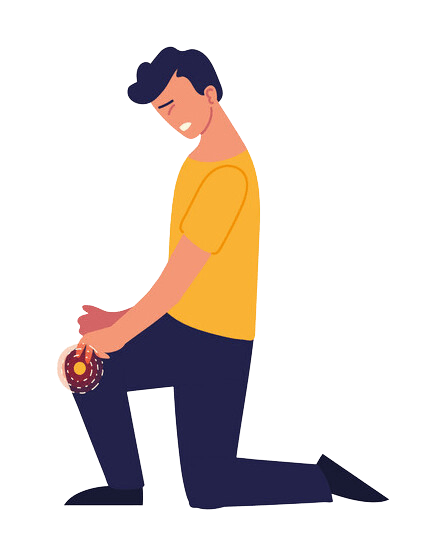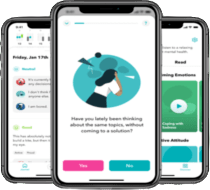Knee pain treatment online | Online Physiotherapy Clinic
- Affordable and reliable knee pain treatment
- Video sessions with expert Physiotherapists/ PTs.
- Specialized physical therapy for knee pain, sprain, bursitis, or stiffness
Begin Therapy
Consult online with best Physios
A New model for Knee Pain Treatment
We understand that it’s difficult for most of us to find time for traditional Knee physical therapy. Physio Mantra brings to you online Knee pain treatment, where all Knee exercises and treatments are managed through regular online check-ins & video sessions.
Expert Physical therapists
Physio Mantra members get matched with a professional physiotherapist for one-on-one Knee pain treatment. They use interactive exercise videos available on our app to treat you.
Continuous Medical Care
Physio Mantra physiotherapists are 100% virtual and provide physical therapy to patients without any time and geographical barriers. Our technology-enabled approach helps manage physical ailments from head to toe.
Personalized Knee therapy
Physio Mantra provides everyday exercises, home remedies, and regular check-ins for all your Knee pain physiotherapy needs. We individualize treatment for each person, with problems including Knee pain, muscle injuries, sprain, bursitis, stiffness, and more.

Best knee Pain Clinic, Now In Your Pocket
Our physical therapists or PTs are available in all parts of the world via an easy-to-use mobile application. The use of artificial intelligence, and data science enables the patients to connect with expert physiotherapists and get real-time insights into their Knee health. Download PhysioMantra App Now

How it works

Signup for our knee Treatment Program
Just fill up a 5-minute online form to tell us about your knee pain history and treatment expectations.

Meet your PT
We will connect you with a physiotherapist who is available 24/7 to you via call or chat.

Connect to our app
Get Physical Therapy sessions on our app via video calls. Follow exercises suggested by our PT and track your progress in the app.
Meet the best online physical therapist
MantraCare physical therapists treat muscle and joint pain problems through a combination of body exercises, video demonstrations, and a healthy diet. Our treatment experience is a better traditional in-person approach in multiple ways.

Dedicated Physio
You get a personal Physio who customizes the exercise plan based on your comfort and needs

App-guided Exercises
3D animations & voice narrations in our app ensure proper and right guidance

Expert care anywhere, anytime
With over 200+ physios, MantraCare is 100% online – no waiting rooms

Exercise Kit
Complete exercise kit with elastic bands, door anchor, and a phone stand – mailed to you
A Complete Guide About Knee Pain Physiotherapy
Understanding Knee Pain
Knee pain is very common, and the causes are usually quite simple. Knee pain is most often the result of an injury such as a ruptured ligament or torn cartilage. Less commonly, it is caused by a condition that may develop over time, like arthritis or gout.
This pain can be mild and temporary or it may be an indication of a serious medical condition.
The knee is made up of three main bones: the femur (thigh bone), tibia (shibula), and patella (kneecap). These bones are held together by muscles, tendons, ligaments, and cartilage which help to stabilize them during movement. When one part becomes injured or damaged due to overuse, stress, or wear-and-tear, pain occurs.
Types of Knee Pain
There are many types of knee pain, but the most common are:
Meniscus Tear
This is a tear in the cartilage that cushions and stabilizes the knee. It is often caused by a sudden twisting or bending of the knee joint.
Osteoarthritis
This is a degenerative condition that affects the joints, most commonly those in the hands, knees, and hips. Over time, the cartilage between the bones wears down, leading to pain and stiffness.
Bursitis
This is an inflammation of one or more bursae sacs located around the joint. Bursae are small fluid-filled sacs that help to cushion and lubricate movable parts of the body.
Patellar Tendonitis
Also known as “jumper’s knee,” this is an overuse injury that affects the patellar tendon, which connects the kneecap to your shinbone. The most common symptom is pain and tenderness just below the kneecap when walking or standing up after sitting for a long time.
Baker’s Cyst
This occurs when fluid builds up behind the knee joint causing swelling and stiffness in that area of your body. It often happens if you have problems with arthritis elsewhere on your body such as rheumatoid or osteoarthritis but it can also result from other causes like an injury or infection near where this cyst forms.
Signs of Knee Pain
There are many signs of knee pain, but some of the most common are:
Swelling
Swelling is often the first sign of an injury and can occur in any part of the knee.
Tenderness
Touching or pressing on the knee joint will cause pain in cases of inflammation, overuse, or infection.
Stiffness
The knee may feel stiffer than usual after sitting for a long time or waking up in the morning. This is common with arthritis and other chronic conditions.
Inability to Fully Bend Knee
If you are unable to bend your knee as much as usual, it may be a sign that something is wrong. This could be due to swelling, pain, or stiffness.
Limping
If you’re experiencing pain in one leg only, it’s likely that you’re limping because your body is trying to protect that leg by not putting as much pressure on it while walking. This can lead to more severe problems down the road so it’s important to get help right away.
Causes of Knee Pain
The most common cause of knee pain is an injury, but there are several other factors that may contribute such as:
Arthritis
Over time, wear and tear on the joints causes them to become inflamed. Arthritis typically affects older people or those with a genetic predisposition for developing this condition. It also tends to affect women more often than men due to hormonal changes during menopause which make bones less dense (osteopenia). This can lead to an increased risk of developing osteoarthritis.
Gout
This is a type of arthritis that is caused by a build-up of uric acid in the blood. It often affects the big toe but can also occur in other joints, including the knee.
Injury
A sudden injury such as a ruptured ligament or torn cartilage can cause pain, swelling, and difficulty moving the joint. Less commonly, an infection or tumor may be the cause of knee pain.
Medical Conditions
There are several medical conditions that can affect the knee and cause pain, including rheumatoid arthritis, psoriatic arthritis, lupus, and gout. These conditions are autoimmune diseases which means that your body’s immune system attacks its own cells.
Treatment Options For Knee Pain
There are many different treatments for knee pain, but the most common are:
Medication
Medication can help to relieve symptoms of an injury or infection, as well as reduce swelling and inflammation caused by arthritis. Anti-inflammatory drugs such as ibuprofen (Advil), naproxen sodium (Aleve), diclofenac sodium (Voltaren) may be prescribed depending on your diagnosis.
Medical Therapy
Sometimes, physical therapy or occupational therapy may be recommended if your knee pain is caused by arthritis. This can help to strengthen the muscles around the affected area and make it easier for you to perform daily activities without causing additional damage.
Surgery
If all other treatments fail, surgery might be the last resort option for some people who have severe cases of osteoarthritis in their knees. However, this procedure carries significant risks and should only be considered as an absolute last resort after trying all other options first (if possible).
Physical Therapy
Physical therapy is a common treatment for knee pain that is caused by arthritis, an injury, or another medical condition. Physical therapists will create a personalized program to help you improve your range of motion, strength, and flexibility. This can help you to better manage your symptoms and stay active.
Physiotherapy For Knee Pain
Physiotherapy can help strengthen the muscles around your knee joint and reduce pain from arthritis or an injury. It also helps with swelling, stiffness, inflammation of tendons (tendonitis), fractures in bones near joints such as tibia/fibula that have been broken due to trauma during sports activities like basketball football soccer skiing snowboarding etcetera.
A physical therapist will design an individualized exercise program for you based on your needs. This can include stretching exercises to improve flexibility, strengthening exercises for muscles around the knee joint so they don’t overcompensate when doing daily tasks like walking upstairs or standing up from a sitting position without using hands to support themselves; this prevents further injuries down the road too because there’s less pressure exerted onto ligaments and tendons surrounding the knee.
Types of Physiotherapy For Knee Pain
There are many types of physiotherapy treatments available for knee pain. Some of them are:
Cold Compression Therapy
This therapy uses a cold pack or ice to help reduce inflammation and pain. It is often used after an injury.
Ultrasound Therapy
This therapy uses high-frequency sound waves to help reduce inflammation and pain. It is often used after an injury.
Transcutaneous Electrical Nerve Stimulation (TENS)
This therapy uses electrical current to stimulate the nerves. It is often used for chronic pain relief.
Massage Therapy
This therapy uses pressure and massage strokes to help relieve tension and pain. It is often used for chronic pain relief.
Acupuncture
This therapy uses thin needles that are inserted into specific points on the body. It is often used for chronic pain relief. This also helps with overall health and wellness.
Benefits of Physiotherapy For Knee Pain
There are many benefits of physiotherapy for knee pain. Some of them are:
Reduced pain
The treatment helps to reduce inflammation and thus, reduces pain. It also increases the range of motion in the affected area and improves mobility. This helps a person to resume their daily activities without any difficulty.
Increased strength
The treatment strengthens the muscles around your knees which help support your joints better. This will prevent further injuries or damage to your knees in the future.
Helps maintain good health
It is always important to keep yourself healthy because that keeps you fit and active throughout life! Regular exercise, proper diet, adequate sleep, etc., will keep you healthy & happy. IT ALSO HELPS WITH OVERALL HEALTH AND WELLNESS.
Improves quality of life
The treatment helps you to resume your daily activities without any difficulty. It also improves the overall health and well-being of a person which in turn, improves their quality of life! The treatment can be used for both acute (short-term) pain as well as chronic (long-term) pain.
10,000+ Happy Wrist Pain patients from the world

“I was suffering from chronic pain in my knees for over 20 years and it has been so hard trying to live with this condition especially since I have three small children at home who depend on me more than anything else! This Physio Mantra site really gave me hope that there might actually be something out there that could make life easier again without having surgery or taking medication every day. It feels good when people notice how much better I feel after doing these exercises just once each morning before going about their day as usual.”
Kamya, 3 Months at MantraCare
Best physiotherapist from across the world





We treat nearly all muscle and joint issues
Not all physical or muscle problems are the same. Different types of problems require different treatments. At MantraCare, 200+ physical therapist the world cover a range of specialties to meet your needs be it back pain, shoulder pain, or sports injury:
Frequently Asked Questions
It depends on the type of treatment being used, but generally speaking, treatments last anywhere from 30 minutes up to an hour each day over a period of several weeks/months depending upon how severe one’s condition may be. This can vary widely because some people might experience relief after just one session while others require multiple sessions before noticing any effects at all this is why doctors typically recommend a trial therapy to see if it works before committing to anything long-term.
Yes, physiotherapy can be used for both acute (short-term) pain as well as chronic (long-term) pain relief. There are many different types of treatments available that cater to each individual’s needs which is why it is such an effective form of treatment!
Like any other medical procedure, there is always a small risk associated with physiotherapy. However, this risk is typically very low and most people do not experience any side effects at all. It is important to speak with your doctor beforehand about any concerns you may have.
Yes, physiotherapy is a safe form of treatment. It does not require any invasive procedures or surgery so there are no risks associated with it! The only downside might be how long the child needs to stay in one place during their session which could cause some discomfort if they have trouble sitting still for too much time without moving around too much (in other words: keep them busy!)
Here are some exercises you can do at home for knee pain: neck stretches, wrist curls, calf raises; all these exercises help strengthen the muscles around your knees which support joints better! They also prevent further damage or injury by increasing strength and flexibility in those areas as well.
The approximate cost of physiotherapy for knee pain can vary depending on the severity of one’s condition and the type of treatment being used. Generally speaking, it will be more expensive if a person needs to attend multiple sessions each week.
This depends on your insurance plan! Some plans cover some or all of the cost while others do not. It is worth checking into before making any decisions about what kind of treatment you would like to use as an alternative medicine option for knee pain relief so that way if there are no out-of-pocket costs (or very little) then it might make sense financially speaking too.











